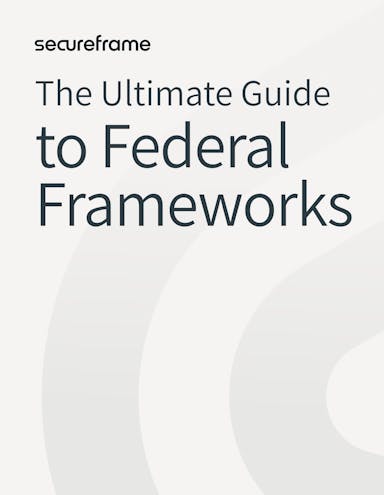
Control Mapping: What It Is & How It Can Help Simplify Your Compliance Efforts
Anna Fitzgerald
Senior Content Marketing Manager
Rob Gutierrez
Senior Cybersecurity and Compliance Manager, CISA, CCSK, CMMC RP
Organizations of all sizes and industries are challenged with complying with multiple laws, regulations, and industry standards. This can result in organizations wasting valuable time and resources creating independent sets of controls, gathering the same evidence, performing redundant tests, and repeating other activities for multiple audits.
One method that can help reduce the time and effort required to comply with multiple frameworks is control mapping. In this post, we’ll cover what control mapping is, what benefits it offers, and how automation can simplify the process.
Before we dive into the definition of control mapping, let’s explain what we mean by control.
What is a control?
A control is a specific safeguard, like a policy, process, configuration, or tool, that an organization puts in place to protect its information assets and manage risk and to achieve compliance with different frameworks.
A framework like PCI DSS or SOC 2® is broken down into key requirements. To comply with a framework, organizations need to implement a set of controls to satisfy all requirements that are relevant to their organization. A control set typically includes a combination of management, physical, legal, operational, and technical safeguards.
In the case of an internal or external audit, organizations must also provide evidence that they adhere to these requirements and that the controls they've put in place are functioning as intended. This evidence is often collected in the form of screenshots, policy and procedure documents, security awareness completion certificates, and/or other types of evidence.
If using a compliance automation platform, it gathers this evidence through integrations and tests. Once you set up integrations with tools and applications that are being used across your organization, the platform will automatically collect evidence and map that evidence to framework requirements and controls via tests. These tests will be passing or failing to indicate the health of your controls.
During a compliance assessment, auditors will then evaluate the organization’s control set and evidence to make sure they are appropriate, effective, and meet framework requirements.
What controls and evidence an organization puts in place varies according to their audit scope, risks, interpretation of the framework requirement, or compliance automation tool. Let’s look at an example.
PCI DSS has several password and authentication requirements, including one that specifies organizations should only use group, shared, or generic accounts when necessary and on an exception basis. One control (among others) that organizations can implement to meet this requirement is using a password manager tool to manage shared accounts and track individual accountability. To prove that this control is in place and operating effectively, they must provide evidence of the password management tool including the configuration of the individual accountability and access restrictions such as a screenshot.
| Definition | Example | |
| Framework | A set of guidelines, rules, and principles established by regulatory bodies, governing bodies, or governments to help organizations protect information assets and manage risks. | PCI DSS |
| Framework requirements | Obligations that an organization must meet in order to achieve compliance with a framework. | Group, shared, or generic accounts, or other shared authentication credentials are only used when necessary on an exception basis. |
| Control | A safeguard, like a policy, procedure, or rule, that an organization puts in place to meet a framework requirement. | Password manager tool is utilized to manage shared accounts and individual accountability. |
| Evidence | Documentation, like screenshots or tickets, that an organization is adhering to framework requirements. | Password policy that mentions the password manager tool in use and supplementary configuration evidence showing the password manager is configured effectively. |
What is a common control?
Controls are designed to be flexible so organizations can tailor them to their specific systems, services, and data types. This ensures that security measures are effective at mitigating the unique risks and challenges the organization faces and not just checking a box for compliance.
Because of this flexibility, some controls can meet the requirements of multiple frameworks. For example, the control of using a password manager tool to manage shared accounts can help meet password requirements for HIPAA and ISO 27001 in addition to PCI DSS. This is an example of a common control.
Many security, privacy, and compliance frameworks have common controls because they were created for similar purposes or types of organizations. For example, federal frameworks like NIST 800-53 and NIST 800-171 were designed to help protect sensitive government information and critical infrastructure. In fact, NIST 800-171 is a derivative of NIST 800-53 so the control sets for each significantly overlap.
Because SOC 2 and ISO 27001 are designed to help service organizations protect customer data and both cover foundational security principles like data security, integrity, availability, and confidentiality, there are many controls that could meet the requirements for both frameworks. Similarly, PCI DSS and HIPAA are frameworks designed to help organizations protect highly sensitive client data and can have significant overlap in their control sets.
Common controls, which meet the intent of requirements across frameworks, can help organizations achieve compliance with multiple frameworks faster and avoid duplicate work. Let’s look at how below.

The Ultimate Guide to Federal Frameworks
Get an overview of the most common federal frameworks, who they apply to, and what their requirements are.
What is control mapping?
Control mapping is the process of implementing a control set that meets the requirements of one framework and then mapping that control set to the requirements of another framework. The goal is to identify common controls that can meet the mapped requirements of multiple frameworks. Because common controls only need to be implemented and tested once to validate that they are effective, organizations can use these results as evidence of adherence to requirements across multiple frameworks. Organizations can therefore achieve compliance with multiple frameworks faster and avoid duplicate work with control mapping.
Let’s take a closer look at the benefits below.
Benefits of control mapping
Control mapping offers several benefits, including speeding up time-to-compliance for multiple frameworks and providing insights to build out your compliance roadmap. It also provides benefits that extend beyond compliance.
1. Reducing duplicate work and speeding up time-to-compliance for multiple frameworks
Mapping controls across relevant regulations and standards can help facilitate the assessment and overall compliance process for multiple frameworks, ultimately saving time for organizations that have already invested resources in achieving compliance for one regulatory framework.
For example, let’s say you start with NIST 800-53 compliance. You determine the appropriate baseline set of controls for your organization is moderate and tailor them accordingly. Then you map them to additional standards and regulations that are required for your organization.
For instance, the AC-1 control from NIST 800-53 is Access Control Policy and Procedures. This can be mapped to controls in other frameworks, like the Annex A.5: Policies for Information Security in ISO 27001. The tests validating the NIST 800-53 AC-1 control could then be applied to the mapped controls for ISO 27001 requirements, saving you from implementing a redundant control and test. This is the concept “test once, comply many.”
By mapping and testing common controls to demonstrate they meet requirements across multiple frameworks, businesses can effectively extend their compliance efforts to multiple frameworks with minimal additional work.
2. Understanding which frameworks make the most sense for your business
Control mapping can provide valuable insights to build out your compliance roadmap. By helping organizations identify overlap as well as gaps across frameworks, control mapping can help them decide which frameworks to pursue compliance for and when.
For example, NIST 800-53 has a comprehensive control set that is broken up into 20 different control families. Many of these control families, like Access Controls, Incident Response, Contingency Planning, and Configuration Management, can be found in other frameworks like:
- NIST 800-171
- CMMC
- NIST CSF
- HIPAA
- PCI DSS
That means NIST 800-53 can be a great starting point for many organizations who need to comply with multiple laws, regulations, and standards now or in the future as their business and customers scale. By pursuing NIST 800-53 compliance first, they’ll be able simplify the process of complying with other frameworks later on using control mapping. NIST 800-53 is so comprehensive they could even be compliant with other frameworks and not know it.
Organizations may also use control mapping to identify gaps between frameworks to understand when it’s necessary to prioritize multiple. Say an organization falls within the scope of PCI DSS and needs to address EU customer concerns about data privacy as well. In that case, they may use control mapping to identify gaps and see that many PCI DSS controls do not map to a sufficient number of GDPR requirements according to their security teams or customers, and then can decide how they want to proceed accordingly.
3. Enhancing risk management
Control mapping can also help enhance an organization's risk management efforts by identifying areas of priority that were not addressed by compliance. That’s why control mapping can be vital for an effective governance, risk, and compliance (GRC) strategy.
For example, an organization may have a significant risk exposure that isn’t addressed in any compliance or regulatory requirement. This risk exposure may be addressed separately by business requirements.
With control mapping, organizations can map controls to both framework and business requirements to improve their risk posture as well as their compliance posture.

Challenges organizations face when control mapping
Now that we understand the benefits of control mapping, let’s take a closer look at common challenges that organizations have to address to unlock those benefits.
Lack of visibility and standardization
If manually mapping controls to framework requirements, then your organization will likely rely on multiple spreadsheets, tools, mapping techniques, and stakeholders. As a result, it can be tedious and time-intensive to create, update, and compare these mappings across different tools and teams. It can also result in inconsistencies and errors.
Knowing whether a control meets mapped requirements
For organizations with limited knowledge and expertise in compliance and security matters, one of the main challenges is understanding whether a control truly meets the intent of a mapped requirement.
Typically, framework requirements are either very specific and complex or broad and too general to know what exactly needs to be implemented. For example, SOC 2 is a guidance created by the AICPA that can be interpreted differently between companies or even audit firms that have their own information requests lists and interpretations. ISO 27001, on the other hand, is more prescriptive and outlines 93 controls — known as “Annex A controls” — that organizations must implement. Because of this disparity in flexibility, organizations may struggle to confidently map SOC 2 controls to ISO 27001 requirements, or vice versa.
To avoid the risks of under- and over-mapping, organizations typically must hire a GRC team and/or legal counsel (depending on the framework) to understand whether controls meet the intent of mapped requirements. This can add to business and compliance costs.
Complexity of frameworks
The risk of under- and over-mapping or making other errors during the mapping process may increase depending on the framework.
Take NIST 800-53, for example. NIST 800-53 has three security control baselines, or sets of minimum security controls for federal information systems based on their impact level. The three baselines are Low, Moderate, and High. Low has the least amount of controls and can be considered the least stringent. High has the most controls and can be considered the most stringent. So mapping the control set of the same framework to different NIST 800-53 baselines will change the number of common controls.
There are also multiple levels of PCI DSS compliance. Depending on what PCI level they fall under, organizations may need to prove their PCI DSS compliance with a report on compliance or self-assessment questionnaire. For merchants and service providers that do not need a full report on compliance, there are eight types of self-assessment questionnaires. So mapping a control set to PCI SAQ A and the baseline framework PCI DSS, for example, will change the number of common controls.
These are just two examples that highlight the complexity of control mapping and potential pitfalls that organizations may need to avoid if taking a manual approach.
Mapping evidence as well as controls
Seeing how many controls two frameworks have in common is helpful, but it does not indicate how compliance with one framework will help speed up compliance to another. To do so, you have to map evidence as well.
Mapping both the control set and evidence of compliance with one framework to another can be a significant amount of work. Just as some framework requirements require an organization to implement multiple controls, some controls require multiple pieces of evidence to assess whether it is effective or healthy.
Take the HIPAA requirement for disposal of ePHI, for example. This states that a covered entity or business associate must, in accordance with § 164.306, implement policies and procedures to address the final disposition of electronic protected health information, and/or the hardware or electronic media on which it is stored. To meet this requirement, organizations may have to implement and test multiple controls like:
- Formalizing a data retention and disposal policy
- Implementing a process for data deletion
- Implementing a process for responding to customer requests to remove data
Since these controls also apply to other frameworks such as CCPA, GDPR, ISO 27001, HIPAA, and SOC 2, then the underlying evidence and processes will address multiple tests and framework requirements and must be mapped as well.
Let’s take a closer look at how a compliance automation platform like Secureframe can solve these challenges and simplify and streamline the control mapping process.
Recommended reading

5 Hardest Things About Security Compliance and How Technology Can Help
How a compliance automation platform simplifies control mapping
Now that you understand the benefits and challenges of control mapping, let’s take a closer look at how a compliance automation platform can significantly simplify control mapping and maximize the ROI of this process.
1. Centralizes framework requirements, control, and test data
Having a central repository for your framework requirements, control, and tests can significantly simplify the control mapping process.
From this single source of truth, you can more easily map controls and tests to new framework requirements to determine whether they can be met by existing controls or need new ones to be implemented and tested.
This visibility alone can unblock your control mapping efforts — but automation can accelerate them.
2. Automates control mapping to reduce error and time
A robust GRC platform like Secureframe can automate the control mapping process, reducing the time it takes and potential for human error.
Secureframe users can access a full list of controls that apply to their organization and see which framework requirements are mapped to each of their controls directly in the platform.
For example, in your Secureframe instance, you may see the control RA-06, which specifies that new vendors must be assessed in accordance with the Vendor Risk Management Policy prior to engaging with the vendor and re-assessed at least annually.

This control is mapped to dozens of requirements for ISO 27001, GDPR, CJIS, and other frameworks. This is done automatically so you don’t have to start from scratch when mapping controls or guess whether a control meets a mapped framework requirement.

3. Maps tests automatically as well
As mentioned above, organizations must map the control set and underlying tests of one framework to another in order to understand what additional work is required to comply with that framework and avoid wasting time on any redundant work.
The best compliance automation platforms will automate the mapping of both controls and tests to framework requirements. That way, you only have to implement and test a common control once to meet multiple framework requirements. Take the control RA-06 for example again. One test (among others) to prove that the control is functioning as intended is to assess risk levels for all in-scope vendors. This test is mapped to controls and requirements across a dozen frameworks, including SOC 2, ISO 27001, HIPAA, CCPA, NY DFS, Cyber Essentials, and more.

So say you’ve implemented and tested the RA-06 control as part of your SOC 2 compliance efforts. If you’re pursuing ISO 27001 compliance next, the control and tests will automatically be mapped to the relevant ISO 27001 requirement so you can prove adherence without additional work.
4. Uses common controls when possible
A compliance automation platform that offers pre-built frameworks, controls, and tests can significantly simplify the compliance process by showing exactly what you need to do to become compliant. If those pre-built frameworks utilize common controls, your team can save even more time and avoid doing duplicate work.
All Secureframe-authored frameworks utilize common controls. That means when an existing Secureframe customer adds a new framework to their instance, they will automatically see where they stand with that framework and how much it overlaps with other frameworks. Due to such common overlap across frameworks, existing Secureframe customers adding new frameworks to their instance never start at 0%.
5. Can map risks to controls
A compliance automation platform with advanced mapping capabilities can even enable you to map your controls to risks to align your compliance and risk management programs. By doing so, you can display the steps you have taken to mitigate risk and more easily identify gaps to proactively treat and respond to risk.
Recommended reading

What Is Risk Mitigation? + Strategies
How Secureframe can help you speed up time-to-compliance
Secureframe is designed to help organizations reduce duplicate work and speed up time-to-compliance, whether they’re pursuing compliance for one framework or many.
All Secureframe-authored frameworks utilize common controls where possible to ensure a sleek compliance program. That means you can access a full list of controls that apply to your organization and see which framework requirements and tests are mapped to each of your controls directly in the Secureframe platform.
You also have the ability to create your own custom frameworks and map both custom and pre-built controls and tests to those framework requirements. You can even edit controls and test mappings to fine-tune the platform to meet your requirements effectively over time.
You can also map controls to risks as well as compliance requirements. That way, if your organization has a significant risk exposure that isn’t addressed by any compliance or regulatory requirements, you can identify and respond to it.
A survey of Secureframe users conducted by UserEvidence confirmed that using a compliance automation platform helps to reduce the complexity and cost of risk and compliance. When asked how Secureframe helped them improve:
- 97% said they strengthened their security and compliance posture
- 92% said they reduced time spent on manual tasks
- 89% said they sped up time-to-compliance for multiple frameworks
- 85% said they unlocked annual cost savings
- 75% said they reduced the risk of non-compliance
To learn more about Secureframe frameworks, controls, and tests, schedule a demo with one of our compliance experts. You can also browse our frameworks glossary to get an overview of some of the hundreds of standards and frameworks that may apply to your organization.
About the UserEvidence Survey
The data about Secureframe users was obtained through an online survey conducted by UserEvidence in February 2024. The survey included responses from 44 Secureframe users (the majority of whom were manager-level or above) across the information technology, consumer discretionary, industrials, financial, and healthcare industries.
FAQs
What is control mapping?
Control mapping is the process of implementing a control set that meets the requirements of one framework and then mapping that control set to the requirements of another framework in order to identify common controls. Typically, control mapping involves creating a map or diagram that illustrates the relationships between frameworks, but this process can be automated using GRC tools.
Why is control mapping important?
Control mapping is important for identifying overlaps and gaps in controls across frameworks, which can help an organization determine which frameworks to prioritize on their compliance roadmap and reduce the work needed to demonstrate compliance across multiple frameworks.
How do you map risks and controls?
Control mapping can be used in risk management as well as compliance. To map risks and controls, start by identifying risks as well as their likelihood and impact. Then identify controls, or actions or safeguards that can be put in place to mitigate those risks. One control may be mapped to several risks.
Use trust to accelerate growth

Anna Fitzgerald
Senior Content Marketing Manager
Anna Fitzgerald is a digital and product marketing professional with nearly a decade of experience delivering high-quality content across highly regulated and technical industries, including healthcare, web development, and cybersecurity compliance. At Secureframe, she specializes in translating complex regulatory frameworks—such as CMMC, FedRAMP, NIST, and SOC 2—into practical resources that help organizations of all sizes and maturity levels meet evolving compliance requirements and improve their overall risk management strategy.

Rob Gutierrez
Senior Cybersecurity and Compliance Manager, CISA, CCSK, CMMC RP
Rob Gutierrez is an information security leader with nearly a decade of experience in GRC, IT audit, cybersecurity, FedRAMP, cloud, and supply chain assessments. As a former auditor and security consultant, Rob performed and managed CMMC, FedRAMP, FISMA, and other security and regulatory audits. At Secureframe, he’s helped hundreds of customers achieve compliance with federal and commercial frameworks, including NIST 800-171, NIST 800-53, FedRAMP, CMMC, SOC 2, and ISO 27001.